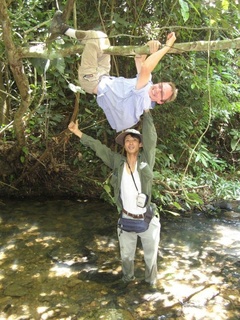 Grootaert (RBINS), Constant (RBINS) & Limbourg (RBINS) (2010-2013)
Grootaert (RBINS), Constant (RBINS) & Limbourg (RBINS) (2010-2013)
Promoted by: Dr Patrick Grootaert (RBINS)
Local partner
The Institute of Ecology and Biological Resources, Department of Insect Systematics, Hanoi, Vietnam (IEBR) is the Vietnamese partner of this project. Partner with whom the RBINS (Entomology Department) is in a MoU since 2007. This project, started in 2010 and renewed in 2011, continues and complements the collaboration between Mr. Hong Thai Pham (IEBR) and Mr. Jérôme Constant (RBINS) as initiated in 2007. Read more on Mr Pham's GTI page regarding the latter cooperation.
The involved staff of the two institutions are: Mr. J. Constant (RBINS), Mr. P. Limbourg (RBINS), Mr. J. Bresseel (collaborator, RBINS), Mr HT Pham, Mrs. Thi Quynh Nga Cao (IEBR) and Mr. Hoang Vu Tru (IEBR)
Identified taxonomic impediments
Main taxonomic needs: (1) access to documentation, (2) access to optical and imaging material (stereomicroscope and camera), (3) training on identification and dissection techniques, (4) training on collecting techniques.
Main curatorial needs: access to knowledge, equipment and supplies to render the IEBR into a state-of the art modern entomological research facility
Objectives
- Collecting, identifying and inventory of several target groups (i.e.Hemiptera: Fulgoridae, Eurybrachidae & Cicadidae; Heteroptera: Pentatomidae; Coleoptera: Rutelinae; Lepidoptera: Saturniidae & Phasmoptera) in several national parks or reserves in Northern and Central Vietnam. This will also be achieved through the training of the Vietnamese members of the staff to relevant field collecting techniques and to some identification routines. All participants will be trained to general entomological collecting and to specific collecting of the groups studied by the other members of the staff in order to reach the best efficiency as a group during fieldwork.
- Improvement of the entomological collections, of the collections management and of the study of the material preserved in IEBR. Environmental conditions, including insect pest management, as well as structural and staff organization, will be evaluated. If necessary, pragmatic solutions will be proposed. The objective is to develop in IEBR a modern reference collection of national, regional and international importance, using the best international standards, and to provide material allowing state-of-the-art mounting and study of the specimens.
Poverty reduction components
Three components are identified:
- The development of the reference collections in IEBR, together with the improvement of the identification and taxonomic capacities of the local staff will facilitate the study of the entomofauna. Those could also be used by researchers from close third countries like Laos or Cambodia.
- The studied groups contain species which are known to damage cultures. Not yet identified species are also reported as pests and it will be of critical interest to build identification capacities for those groups.
- Species of the studied groups are known to damage cultivated plants and have negative effects on the crops: Fulgoridae (e.g. Pyrops candelaria on litchi), sucking the sap of the tree, Cicadidae on coffee and other cultivated trees, sucking the sap of the roots (nymphs) or of the trees (adults), Pentatomidae on cabbage, Rutelinae and Melolothinae eating roots and leaves of an important number of plants and trees, sometimes causing spectacular damage. At least 3 species of Phasmoptera are reported as serious pests in forests of southern China, sometimes defoliating several ha of forest (with reported numbers of 5000 specimens per single tree!).
Scientific capacity building
Both soft and hard capacity building is aimed at in this project
Soft capacity building is achieved by providing training in collection management of the existing collections and by providing training in sampling, preserving, mounting, dissecting, labeling and identification of specimens.
Hard capacity building is achieved by equiping the IEBR with the needed scientific literature, small entomological equipment such as insect pins of various sizes and sampling devices (nets, traps, lights) and - on the explicit demand of the IEBR - a dissecting microscope equiped with a digital camera.
Expected output
It is expected that this capacity building project will result in the production of species checklists of the studied groups for the locations investigated. The project participants also aim to produce a guide to the Lantern-flies (Fulgoridae) of Vietnam in the series Abc Taxa and will publish their findings (ao. description of several species new to science) in established scientific journals.
It is also envisaged to organize a training workshop on Homoptera in 2012.






Top row (left) Mr. Pham and Constant set up a trap; (right) light trap with a spectacular yield; Middle row (left): setting up traps sometimes requires tree climbing skills (right) a spectacular fulgorid; bottom row (left) a saturnid; (right) Hanoi market exposing remarkable biodiversity richness.
Read more on the progress of this project in the preliminary and year-1-report of Mr Constant or in the publcations of their publications:
- Constant, J. & Pham, H.T. 2011. Two new species of Hemisphaerius from Vietnam (Hemiptera, Fulgoromorpha, Issidae). Nouv. Revue Ent. (N.S.) 27 (2): 109-115. (full paper available on request)

